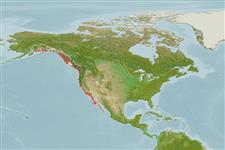Environment: milieu / climate zone / depth range / distribution range
Ökologie
seewasser demersal; tiefenbereich ? - 30 m (Ref. 2850). Subtropical; 61°N - 20°N, 154°W - 114°W
Eastern Pacific: northern British Columbia, Canada to central Baja California, Mexico, including Guadalupe Island, off north central Baja California.
Size / Gewicht / Alter
Maturity: Lm ? range ? - ? cm
Max length : 22.0 cm TL Männchen/unbestimmt; (Ref. 2850)
Rückenflossenstacheln (insgesamt) : 7 - 9; Rückenflossenweichstrahlen (insgesamt) : 13 - 16; Afterflossenstacheln: 3; Afterflossenweichstrahlen: 21 - 24; Wirbelzahl: 31 - 34. Color variable, olive brown to coppery above lateral line, with dark pigment under each scale, bright below lateral line; dark on axil; fins either pale or rosy (Ref. 6885).
Found among giant kelp, usually up in kelp canopy. Feed on small crustaceans, especially ones that live on kelp. Also a cleaner which picks external parasites from other fishes. Usually occur in large aggregations in summer (Ref. 2850). Viviparous, female carries the developing young (Ref. 205).
Life cycle and mating behavior
Geschlechtsreife | Fortpflanzung | Ablaichen | Eier | Fecundity | Larven
Viviparous, female carries the developing young (Ref. 205).
Eschmeyer, W.N., E.S. Herald and H. Hammann, 1983. A field guide to Pacific coast fishes of North America. Boston (MA, USA): Houghton Mifflin Company. xii+336 p. (Ref. 2850)
IUCN Rote Liste Status (Ref. 130435: Version 2024-1)
Bedrohung für Menschen
Harmless
Nutzung durch Menschen
Fischereien: kommerziell; Aquarium: Öffentliche Aquarien
Tools
Zusatzinformationen
Download XML
Internet Quellen
Estimates based on models
Preferred temperature (Ref.
123201): 8.4 - 18.3, mean 10.7 °C (based on 229 cells).
Phylogenetic diversity index (Ref.
82804): PD
50 = 0.7500 [Uniqueness, from 0.5 = low to 2.0 = high].
Bayesian length-weight: a=0.01318 (0.00547 - 0.03178), b=3.05 (2.84 - 3.26), in cm total length, based on LWR estimates for this (Sub)family-body shape (Ref.
93245).
Trophic level (Ref.
69278): 3.5 ±0.50 se; based on food items.
Widerstandsfähigkeit (Ref.
120179): hoch, Verdopplung der Population dauert weniger als 15 Monate. (tm=1).
Fishing Vulnerability (Ref.
59153): Low vulnerability (12 of 100).
Nutrients (Ref.
124155): Calcium = 155 [85, 298] mg/100g; Iron = 1.43 [0.91, 2.36] mg/100g; Protein = 19.1 [18.3, 20.0] %; Omega3 = 0.368 [0.238, 0.576] g/100g; Selenium = 20.5 [11.1, 39.0] μg/100g; VitaminA = 13.1 [4.8, 35.6] μg/100g; Zinc = 0.956 [0.691, 1.351] mg/100g (wet weight);
